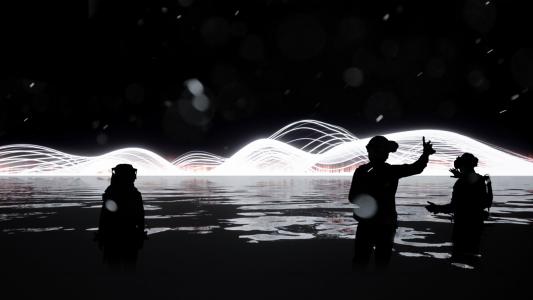This article is an installment of The Future Explored, a weekly guide to world-changing technology. You can get stories like this one straight to your inbox every Thursday morning by subscribing here.
Last month, VR startup OVR announced a new platform that increases immersion for users — not through visuals — through smell. Dubbed the INHALE Wellness Platform, the effort seeks to bring about the next generation of aromatherapy through VR.
Smells are produced through the company’s ION device, a headset attachment that includes vials of different scents that can be triggered by users’ movements or experiences in VR.
Aromatherapy joins OVR’s “Shifting Homes,” a VR experience that incorporates smell to viscerally immerse audiences in the experience of climate change in the Pacific island of Samoa, a country under threat from rising sea levels.
In the experience, smells range from sandy beaches (in calm weather) to smoke from fires caused by a lightning strike. OVR worked with artist Daniel Stricker of DP Immersive to gather scents from the island, which the startup then used to develop scents for ION in its Vermont lab.
Why smell, why now?
VR visually immerses users in digital worlds, and advances in spatial audio continue to add sonic elements that deepen the experience. But smell has proved trickier; as an industry colleague once said to me: you can’t pause smell.
The lack of immersive scent has been a big loss for VR — a medium whose promise is lifelike immersion into alternate realities. Smell is the sense most closely linked to memory. Researchers believe this could have to do with how smell operates within the brain.
With every other sense — sight, sound, touch, and taste — the “data” we perceive is first interpreted by the thalamus, a sort of “relay station.” Once processed by the thalamus, only then is this information passed on to other areas of the brain.
But, as Ashley Hamer writes in Discovery, “Scents bypass the thalamus and go straight to the brain’s smell center, known as the olfactory bulb. The olfactory bulb is directly connected to the amygdala and hippocampus, which might explain why the smell of something can so immediately trigger a detailed memory or even intense emotion.”
Smell-O-Vision: People have been wanting to incorporate smell into TV and film for over a century; the earliest known use of scent in conjunction with film is 1906.
In the 1940s, ’50s, and ’60s, efforts like AromaRama and Smell-O-Vision sought to bring smell to mass audiences, but despite a lot of hype, they never actually took off.
The New York Times didn’t pull any punches when it described one such effort in 1959 as “capricious … elusive, oppressive or perfunctory and banal … merely synthetic smells that occasionally befit what one is viewing, but more often they confuse the atmosphere.”
Common scents: VR offers unique opportunities related to smell. Where film and TV present content in two dimensions, VR is meant to fully immerse users individually. And because of the proximity of headsets to users’ noses, smell can be delivered more precisely, through attachments like ION, than in an open environment like a movie theatre.
OVR claims its technology allows for “.1 millisecond bursts of scent (that) can change between scents in 20 milliseconds.” The scents can be personal and specific to what the user is doing — in addition to environmental scents, like beach air, the ION can also be triggered by interacting with virtual objects.
Virtual sunshine for the mind
VR delivers a wide variety of experiences, from games and narrative content to training and education. But it also has potential for delivering virtual therapeutics — using VR as a tool to promote healthier connections between body and mind.
The startup is betting that aromatherapy can become a major part of virtual therapeutics. INHALE situates users in a relaxing environment, where they take part in guided meditations that involve smells like pine forests, an ocean breeze, and fresh-cut grass.
OVR’s Wisniewski sees these visual-olfactory experiences as capable of promoting mindfulness and wellbeing — mitigating stress, burnout, and negative thoughts.
“Smell…plays a critical role in human motivation and behavior,” Wisniewski said in a statement. “That makes it an extremely important aspect of outcome-oriented VR experiences and especially relevant as an affordable and scalable tool to enhance access to integrative health, mental health, and wellbeing management.”
We’d love to hear from you! If you have a comment about this article or if you have a tip for a future Freethink story, please email us at tips@freethink.com.
